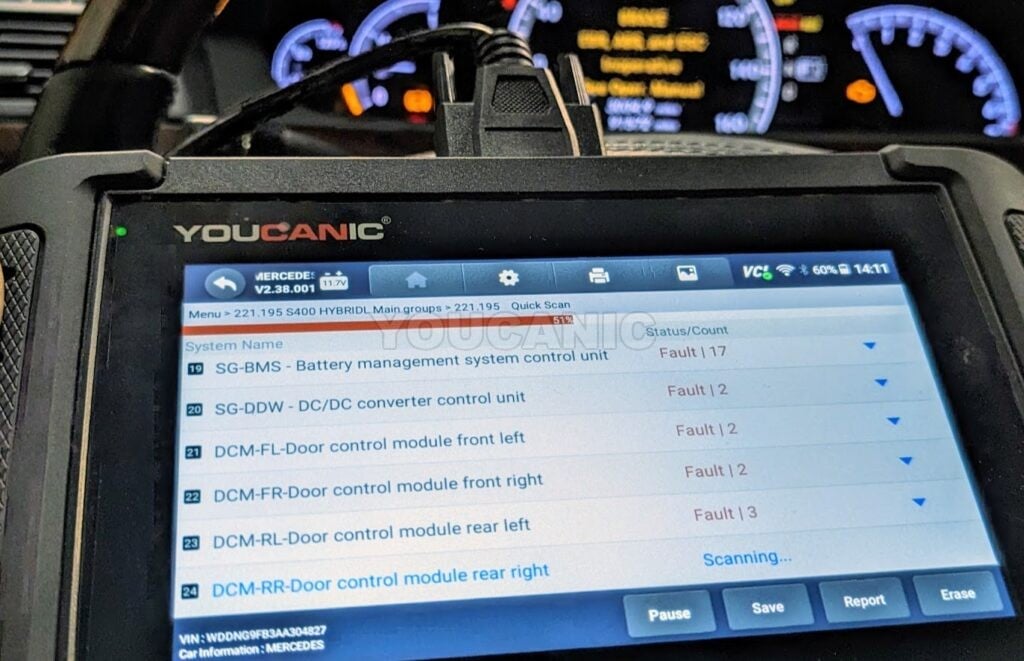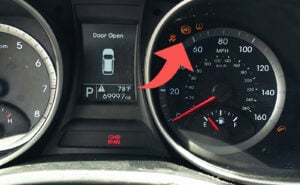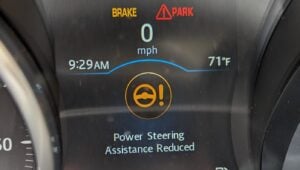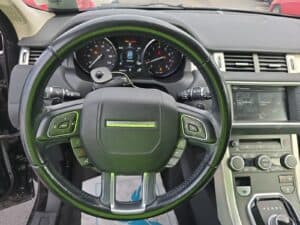Jaguar ABS & Traction Control Light On
The Anti-lock Braking System (ABS) is an important safety feature in your Jaguar. When the ABS light illuminates, it means that there is an issue within the system that needs attention. In this article, we explore the common causes behind ABS, stability control, and traction control lights. By understanding common causes, vehicle owners can address ABS malfunctions on their own, ensuring their safety on the road. We’ll tackle sensor malfunctions, ABS module failure, and other possible causes to understand what’s wrong with your Jaguar.
What does the ABS light mean on a Jaguar?

The Anti-lock Braking System (ABS) reduces the braking distance during sudden braking by regulating the hydraulic braking pressure. This prevents the locking of brakes and skidding of tires. If there is a problem within the system, the ABS light turns on, alerting the driver. It is important to fix the issue immediately to prevent accidents while driving, especially in slippery road conditions.
Symptoms






- ABS Light Stays On
- ABS Not Available and Trac Control Not Available Message
- ABS Fault, DSC Not Available, Parking Break Fault, and Transmission Fault Message
- ABS, Check Engine, and Brake are ON
- Stability Control Not Available Drive with Care – Stability Control Light Stays On
- ABS Fault Warning Message on the Dashboard
- ASPC Not Available Warning Message
Common Causes
There are several reasons why the ABS light turns on in your Jaguar XE, XF, F-type, and many more models. Failure of the ABS wheel speed sensor is the most common cause and has the cheapest replacement part. Replacing a wheel speed sensor costs around $50 and takes 30 minutes to install. Other common causes are a blown fuse, faulty ABS module, defective steering angle sensor, weak batteries, and many more.
Malfunctioning ABS Wheel Speed Sensor

The ABS wheel speed sensor monitors each wheel’s wheel speed. It detects the rotational speed of each wheel and relays the information to the ABS module. The ABS module uses this information to apply the necessary braking force during sudden or emergency braking to prevent the brakes from locking up.
A faulty sensor can also send inaccurate signals to the ABS module and turns on the ABS light. Many factors can cause the wheel speed sensor to fail. Dirt and debris can accumulate on the sensor, making the signal inaccurate. A simple cleaning can sometimes fix the issue.
Defective ABS Module

The ABS control module controls the entire anti-lock braking system. It collects information from all the sensors and regulates the braking pressure using pumps and valves to prevent wheels from locking up. When there is a malfunction within the ABS module, the ABS light turns on to alert the driver.
An ABS module can be damaged due to a variety of reasons. One of the most common causes is an electrical issue, such as a short circuit inside the main circuit board. Electrical problems can prevent the module from receiving accurate signals from the wheel speed sensors.
Defective ABS Accumulator
The ABS accumulator is a critical component of the ABS in a Jaguar. It is responsible for storing and supplying hydraulic pressure to the ABS. The accumulator acts as a reservoir of pressurized brake fluid that can be released quickly and smoothly to the brakes during sudden or emergency stops.
A defective or malfunctioning ABS accumulator can impact the reliability and accuracy of the ABS. The accumulator may fail to maintain proper pressure or leak hydraulic fluid, which can reduce braking performance or cause the ABS to fail.
Most modern Jaguars come equipped with an ABS accumulator as a part of their anti-lock brake system. Some of the models that are known to have an ABS accumulator include:
- Jaguar XJ (X350/X358)
- Jaguar XK (X150)
- Jaguar XF (X250)
- Jaguar XE (X760)
- Jaguar F-Type (X152)
- Jaguar S-Type (X200/X202/X204)
Defective Steering Angle Sensor

The ABS uses the steering angle sensor to properly detect how the vehicle turns to regulate the braking pressure. The Traction control system also uses the steering angle sensor to prevent skids during slippery road conditions.
A faulty SAS can send inaccurate signals to the ABS module, thus turning the ABS light on. The ABS and traction control warning light simultaneously lights up if the SAS is faulty.
Weak Battery

The anti-lock braking system uses the battery to power the whole system. It needs a constant and steady supply of voltage to function properly. When the battery voltage drops, the ABS cannot function and turns the ABS light on. Replacing the battery if the voltage drops is important to prevent problems within the ABS.
Damaged or Broken Wires

The wires and connectors are susceptible to damage due to their location close to the wheels, exposed to harsh conditions, dirt, and debris. A damaged wire or connector can result in a loss of communication between the ABS module and sensors, thus turning on the ABS light.
Vibration from the road and the engine can make the connectors lose, thus disconnecting them from the ABS module. Weather can also affect the damage to the wires and connectors. It can wear it out and damage it. Also, exposed wires can touch and cause a short circuit that can damage the control module.
Blown Fuse or Bad Relay

A blown fuse or bad relay can cause the ABS warning light to illuminate on the dashboard, indicating a malfunction in the ABS. A blown fuse can result from excessive electrical current, while a bad relay can occur due to wear and tear or an electrical overload. Both issues can interrupt the flow of electrical current and prevent the ABS from functioning correctly, leading to the illumination of the ABS warning light.
Low brake fluid level

A low brake fluid level can indicate a leak in the brake system or worn brake pads. When the brake fluid level is low, the hydraulic pressure in the brake lines and hydraulic system decreases, which can cause the ABS to malfunction, leading to the ABS light turning on. In this situation, the ABS may not function correctly, reducing braking power.
Troubleshooting & Reset Procedure

The ABS and traction control warnings on Jaguar vehicles may come on for a number of reasons. The best way to find out what is wrong with your Jaguar is to scan the vehicle for fault codes. A good diagnostic scanner such as a YOUCANIC scanner will be able to read and clear codes from all the control units of the vehicle including the ABS control module.
- Locate the OBD II port under the dash of your vehicle. It is usually located near the driver’s side and is a 16-pin connector.
- Plug in the scanner and turn on the ignition, but do not start the engine.
- Select the make of your vehicle from the list of available makes. You can select “Auto Detect VIN” to automatically detect your vehicle’s make and model.
- Select “Control Units,” then “ABS/Traction Control Module.” Remember that the name of this module may vary depending on the make and model of your vehicle.
- Once the scanner is on, select “Diagnostics” from the main menu.
- Once you have selected the ABS/Traction Control Module, you can select “Read Codes” to see any stored trouble codes related to the ABS. The scanner will display the current codes, which will help you determine what may be causing the ABS and traction control warnings to turn on.
- Based on the codes, the scanner may suggest performing further tests or inspecting certain components of the ABS, such as the wheel speed sensors, brake lines, and hydraulic control unit.
- Once the underlying issue has been fixed, then select Clear Codes to clear fault codes stored in the ABS control unit and reset ABS and traction control warning lights.
Fault Codes
A partial list of possible fault codes that may be present in the ABS control unit when reading the codes.
- C1095 – ABS Hydraulic Pump Motor Circuit Failure
- C1165 – Right Rear Wheel Speed Sensor Input Circuit Failure
- C1175 – Left Rear Wheel Speed Sensor Input Circuit Failure
- C1233 – ABS Hydraulic Pump Motor Control Circuit
- C1234 – ABS Hydraulic Valve Circuit Failure
- C1235 – ABS Inlet Valve Coil Rear Circuit Failure
- C1236 – ABS Inlet Valve Coil Front Circuit Failure
- C1237 – ABS Outlet Valve Coil Rear Circuit Failure
- C1238 – ABS Outlet Valve Coil Front Circuit Failure
- C1301 – ABS Pump Motor Circuit Failure
- C1302 – ABS Motor Feedback Circuit Failure
- C1305 – ABS Solenoid Output Circuit Failure
- C1306 – ABS Solenoid Output Circuit Open
- C1307 – ABS Solenoid Output Circuit Shorted
- C1313 – ABS Pump Motor Control Circuit Failure
- C1805 – Brake Switch Input Circuit Failure








